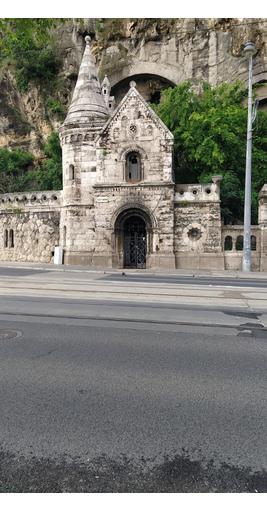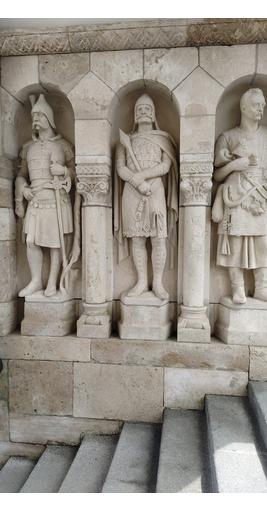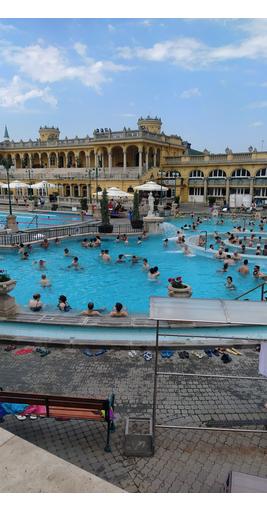Budapest
|
|
The moment I stepped into Széchenyi Thermal Bath in Budapest, I felt like I had entered a dream—a surreal blend of history, architecture, and relaxation. The grand Neo-Baroque building, with its golden-yellow façade, stood like a palace against the clear blue sky, instantly making me feel like royalty. The sheer size of the place was overwhelming. I had read about it being one of the largest thermal bath complexes in Europe, but seeing it in person was a completely different experience. The air carried a faint, mineral-rich scent, reminding me that these waters had been bubbling beneath the city for centuries. Walking through the main entrance, I was greeted by elegant archways and intricate mosaics that exuded old-world charm. The ticketing process was straightforward, and within minutes, I was handed a wristband that granted access to the baths. The changing rooms were clean and well-organized, though I found them slightly confusing at first. After changing into my swimsuit, I followed the flow of visitors towards the outdoor pools, eager to see what made this place so famous. The first sight of the outdoor pools was breathtaking. Steam rose from the turquoise water, creating an almost mystical atmosphere, especially as the crisp air of the early morning surrounded me. The main thermal pool, with its elegantly sculpted fountains and classical statues, was the centerpiece of the courtyard. It looked like something out of a painting. I dipped my feet in cautiously, expecting the water to be lukewarm, but it was delightfully warm, around 38°C (100°F). The sensation was instantly soothing, as if the thermal waters were melting away all my stress. Floating in the warm water, I watched locals playing chess at the poolside tables, their expressions calm yet focused. It was fascinating to see them so immersed in the game, completely unbothered by the surrounding crowd. This was clearly a ritual for many Hungarians, who have been coming here for generations. The blend of tourists and locals created a unique, friendly atmosphere, where people from all over the world gathered for the simple joy of relaxation. Curious to explore more, I ventured inside to the indoor pools and saunas. The variety was impressive—there were hot and cold pools, steam rooms, and even a whirlpool. Each pool had a different temperature, some as hot as 40°C (104°F) and others shockingly cold, perfect for contrast therapy. I tried the sauna next, where the intense heat made my skin tingle before I plunged into a cold pool nearby. The sudden chill sent a shiver down my spine but left me feeling completely refreshed. As I walked around, I couldn’t help but marvel at the historical significance of this place. Built in 1913, the Széchenyi Baths have long been a cornerstone of Budapest’s thermal bath culture. The healing properties of the mineral-rich waters, sourced from natural hot springs deep below the city, have been cherished for centuries. It was easy to see why—my muscles felt lighter, my mind clearer, and my body deeply relaxed. After a few hours of soaking and unwinding, I reluctantly decided to leave. As I stepped out into the city streets, I felt completely rejuvenated, as if I had been transported to another time and place. Széchenyi Bath wasn’t just a spa; it was an experience—a magical escape that I knew I would return to again.
One of the first places I visited in Budapest was Buda Castle, a magnificent historical complex perched high on Castle Hill. The journey up itself was an adventure—I had two choices: take the historic Budavári Sikló funicular, a wooden tram dating back to 1870, or walk up the winding cobblestone paths while enjoying the city views. I opted for the funicular, and as it climbed the hill, I watched the rooftops of Budapest gradually unfold before me. At the top, I was greeted by the grand Buda Castle, a UNESCO World Heritage site that has stood for centuries, once serving as the royal residence of Hungarian kings. The castle’s architecture was a mix of Baroque, Gothic, and Renaissance styles, reflecting the many historical changes the city had gone through. As I walked through its expansive courtyards, I could feel the weight of history embedded in its ancient stones. One of the highlights inside was the Hungarian National Gallery, where I saw an impressive collection of Hungarian art, ranging from medieval altarpieces to 20th-century modern paintings. The detailed brushwork and historic depictions of Hungarian royalty and battles provided a deeper understanding of the country’s rich culture. Beyond the museum, the castle grounds offered stunning panoramic views of the Danube River and the Pest side of the city, making it the perfect spot to take photos and appreciate Budapest’s skyline. Just a short walk from the castle, Fisherman’s Bastion awaited, looking like something straight out of a fairytale. Its white stone towers, arched walkways, and intricate turrets gave it an almost magical appearance. Built in the late 19th century, it was designed in Neo-Romanesque style and served more as a decorative lookout point rather than a fortress. From the terraces, I had one of the best panoramic views in the entire city—especially breathtaking at sunrise, when the sky was painted in soft hues of pink and orange. Standing there, I was captivated by the sight of the Hungarian Parliament Building across the river, its Gothic Revival spires glowing in the morning light. The tranquility of the moment made Fisherman’s Bastion feel like a peaceful retreat, away from the bustling streets of the city below. As I explored further, I noticed a statue of St. Stephen, the first King of Hungary, a reminder of the deep historical roots tied to this place. Another must-visit landmark was St. Stephen’s Basilica, the largest church in Budapest and an architectural masterpiece. As I stepped inside, I was immediately awestruck by the grandeur of the soaring domes, intricate mosaics, and golden decorations. The sunlight streaming through the stained-glass windows illuminated the detailed frescoes, creating an almost heavenly glow. One of the highlights was ascending to the dome, where an elevator ride took me to the top of the basilica. From there, the 360-degree view of Budapest was absolutely breathtaking—I could see the Buda Hills, the Danube bridges, and the entire cityscape stretching before me. It was the perfect way to end my journey through these magnificent landmarks, leaving me with a deep appreciation for Budapest’s beauty, history, and timeless charm. |


